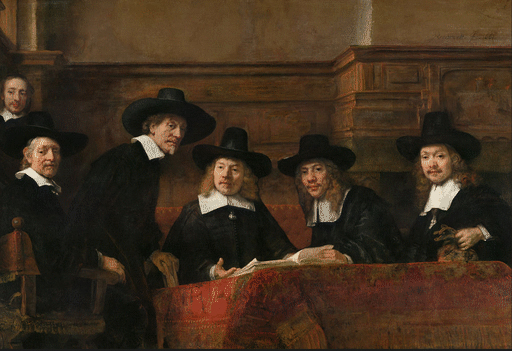References
1ArnoldT.TiltonL.2019Distant viewing: analyzing large visual corporaDigit. Scholarship Humanit.34i3i16i3–i1610.1093/llc/fqz013
2ArnoldT.TiltonL.Distant Viewing: Computational Exploration of Digital Images2023MIT PressCambridge, MA
3BellS.UpchurchP.SnavelyN.BalaK.2013OpenSurfaces: A richly annotated catalog of surface appearanceACM Trans. Graph.321171–1710.1145/2461912.2462002
4BrandhorstH.2013Aby Warburg’s wildest dreams come true?Vis. Res.29728872–88
5BuhrmesterM.KwangT.GoslingS. D.2011Amazon’s Mechanical Turk: A new source of inexpensive, yet high-quality, data?Perspect. Psychol. Sci.6353–510.1177/1745691610393980
6BuhrmesterM.KwangT.GoslingS. D.2011Amazon’s mechanical Turk: A new source of inexpensive, yet high-quality data?Perspect. Psychol. Sci.6353–510.1177/1745691610393980
7ChadwickA. C.KentridgeR.2015The perception of gloss: A reviewVis. Res.109221235221–3510.1016/j.visres.2014.10.026
8ChenW.QianS.FanD.KojimaN.HamiltonM.DengJ.Oasis: A large-scale dataset for single image 3D in the wildProc. IEEE/CVF Conf. on Computer Vision and Pattern Recognition (CVPR)2020IEEEPiscataway, NJ
9ChouJ.-P.StorkD. G.2023Computational tracking of head pose through 500 years of fine-art portraitureElectron. Imaging351131–1310.2352/EI.2023.35.13.CVAA-211
10CrumpM. J.McdonnellJ. V.GureckisT. M.2013Evaluating Amazon’s Mechanical Turk as a tool for experimental behavioral researchPLoS ONE810.1371/journal.pone.0057410
11DaiA.ChangA. X.SavvaM.HalberM.FunkhouserT.NießnerM.ScanNet: Richly-annotated 3D reconstructions of indoor scenesProc. IEEE Conf. on Computer Vision and Pattern Recognition2017IEEEPiscataway, NJ582858395828–39
12DavenportJ. L.PotterM. C.2004Scene consistency in object and background perceptionPsychol. Sci.15559564559–6410.1111/j.0956-7976.2004.00719.x
13EcclesK.GregA.Your paintings tagger: Crowdsourcing descriptive metadata for a national virtual collectionCrowdsourcing our Cultural Heritage2016Routledge185208185–208
14GingoldY.ShamirA.Cohen-OrD.2012Micro perceptual human computation for visual tasksACM Trans. Graph.311121–1210.1145/2231816.2231817
15GoodmanJ. K.CryderC. E.CheemaA.2013Data collection in a flat world: The strengths and weaknesses of Mechanical Turk samplesJ. Behav. Decis. Mak.26213224213–2410.1002/bdm.1753
16GrahamD. J.RediesC.2010Statistical regularities in art: Relations with visual coding and perceptionVis. Res.50150315091503–910.1016/j.visres.2010.05.002
17GryaditskayaY.SypesteynM.HoftijzerJ. W.PontS.DurandF.BousseauA.2019OpenSketch: A richly-annotated dataset of product design sketchesACM Trans. Graph.3823210.1145/3355089.3356533
18HaghiriS.RubischP.GeirhosR.WichmannF.von LuxburgU.
19HollinkL.SchreiberA. T.WielemakerJ.WielingaB. J.Semantic annotation of image collectionsKnowledge Capture 2003–Proc. Knowledge Markup and Semantic Annotation Workshop2003Vol. 2414841–8
20JohnsonM. K.StorkD. G.BiswasS.FuruichiY.2008Inferring illumination direction estimated from disparate sources in paintings: an investigation into Jan Vermeer’s girl with a pearl earringProc. SPIE6810164175164–75
21KoenderinkJ.WijntjesM.van DoornA.2013Zograscopic viewingi-Perception4192206192–20610.1068/i0585
22KoenderinkJ. J.van DoornA. J.KappersA. M. L.1992Surface perception in picturesPerception Psychophysics52487496487–9610.3758/BF03206710
23KoenderinkJ. J.van DoornA. J.KappersA. M. L.ToddJ. T.2001Ambiguity and the ‘mental eye’ in pictorial reliefPerception30431448431–4810.1068/p3030
24KovacsB.BellS.SnavelyN.BalaK.Shading annotations in the wildComputer Vision and Pattern Recognition (CVPR)2017IEEEPiscataway, NJ
25LiuS.ChenC.LuY.OuyangF.WangB.2018An interactive method to improve crowdsourced annotationsIEEE Trans. Vis. Comput. Graphics25235245235–4510.1109/TVCG.2018.2864843
26ManovichL.Cultural Analytics2020MIT PressCambridge, MA
27MarlowP. J.KimJ.AndersonB. L.2012The perception and misperception of specular surface reflectanceCurr. Biol.22190919131909–1310.1016/j.cub.2012.08.009
28McCarthyL.ReasC.FryB.
29MotoyoshiI.MatobaH.2012Variability in constancy of the perceived surface reflectance across different illumination statisticsVis. Res.53303930–910.1016/j.visres.2011.11.010
30MuthC.HesslingerV. M.CarbonC.-C.2015The appeal of challenge in the perception of art: How ambiguity, solvability of ambiguity, and the opportunity for insight affect appreciationPsychol. Aesthetics, Creat., Arts920610.1037/a0038814
31OostermanJ.BozzonA.HoubenG. J.NottamkandathA.DijkshoornC.AroyoL.LeyssenM. H.TraubM. C.Crowd versus experts: nichesourcing for knowledge intensive tasks in cultural heritageProc. 23rd Int’l. Conf. World Wide Web2014567568567–8
32PaolacciG.ChandlerJ.IpeirotisP. G.2010Running experiments on Amazon Mechanical TurkJudgment Decis. Mak.5411419411–910.1017/S1930297500002205
33PellaciniF.FerwerdaJ. A.GreenbergD. P.Toward a psychophysically-based light reflection model for image synthesisProc. 27th Annual Conf. on Computer Graphics and Interactive Techniques2000ACM Press/Addison-Wesley Publishing Co.USA556455–6410.1145/344779.344812
34ReasC.FryB.Processing (A Programming Handbook for Visual Designers and Artists)2007The MIT PressCambridge, MA
35RogersS.1996The horizon-ratio relation as information for relative size in picturesPercept. & Psychophys.58142152142–5210.3758/BF03205483
36RussellB. C.TorralbaA.MurphyK. P.FreemanW. T.2008LabelMe: a database and web-based tool for image annotationInt. J. Comput. Vis.77157173157–7310.1007/s11263-007-0090-8
37SchreiberG.AminA.AroyoL.van AssemM.de BoerV.HardmanL.HildebrandM.OmelayenkoB.van OsenbruggenJ.TordaiA.WielemakerJ.WielingaB.2008Semantic annotation and search of cultural-heritage collections: The multimediaN E-culture demonstratorJ. Web Semant.6243249243–910.1016/j.websem.2008.08.001
38SnydmanS.SandersonR.CramerT.The international image interoperability framework (IIIF): A community & technology approach for web-based imagesProc. IS&T Archiving 20152015Vol. 2015IS&TSpringfield162116–21
39ToddJ. T.OomesA. H.KoenderinkJ. J.KappersA. M.2001On the affine structure of perceptual spacePsychol. Sci.12191196191–610.1111/1467-9280.00335
40UpchurchP.SedraD.MullenA.HirshH.BalaK.Interactive consensus agreement games for labeling imagesProc. AAAI Conf. on Human Computation and Crowdsourcing2016Vol. 4239248239–4810.1609/hcomp.v4i1.13293
41Van SchendelA.1956De schimmen van de Staalmeesters: Een röntgenologisch onderzoekOud Holland711231–2310.1163/187501756X00019
42van ZuijlenM. J.LinH.BalaK.PontS. C.WijntjesM. W.2021Materials in paintings (MIP): An interdisciplinary dataset for perception, art history, and computer visionPlos One16e025510910.1371/journal.pone.0255109
43van ZuijlenM. J.PontS. C.WijntjesM. W.2020Conventions and temporal differences in painted faces: A study of posture and color distributionElectron. Imaging2020267-110.2352/ISSN.2470-1173.2020.11.HVEI-267
44WendtG.FaulF.EkrollV.MausfeldR.2010Disparity, motion, and color information improve gloss constancy performanceJ. Vis.10777–10.1167/10.9.7
45WieserC.BryF.BérardA.LagrangeR.ARTigo: building an artwork search engine with games and higher-order latent semantic analysisProc. AAAI Conf. on Human Computation and Crowdsourcing2013Vol. 1152015–2010.1609/hcomp.v1i1.13060
46WijntjesM. W. A.2021Shadows, highlights and faces: the contribution of a ‘human in the loop’ to digital art historyArt & Perception9668966–8910.1163/22134913-bja10022
47WijntjesM. W. A.2014A new view through Alberti’s windowJ. Exp. Psychol.: Hum. Perception Perform.4048810.1037/a0035396
48WijntjesM. W. A.PontS. C.2010Pointing in pictorial space: Quantifying the perceived relative depth structure in mono and stereo images of natural scenesACM Trans. Appl. Perception (TAP)7181–810.1145/1823738.1823742
49WillatsJ.Art and Representation: New Principles in the Analysis of Pictures1997Princeton University PressPrinceton
50YarbusA. L.

 Find this author on Google Scholar
Find this author on Google Scholar Find this author on PubMed
Find this author on PubMed